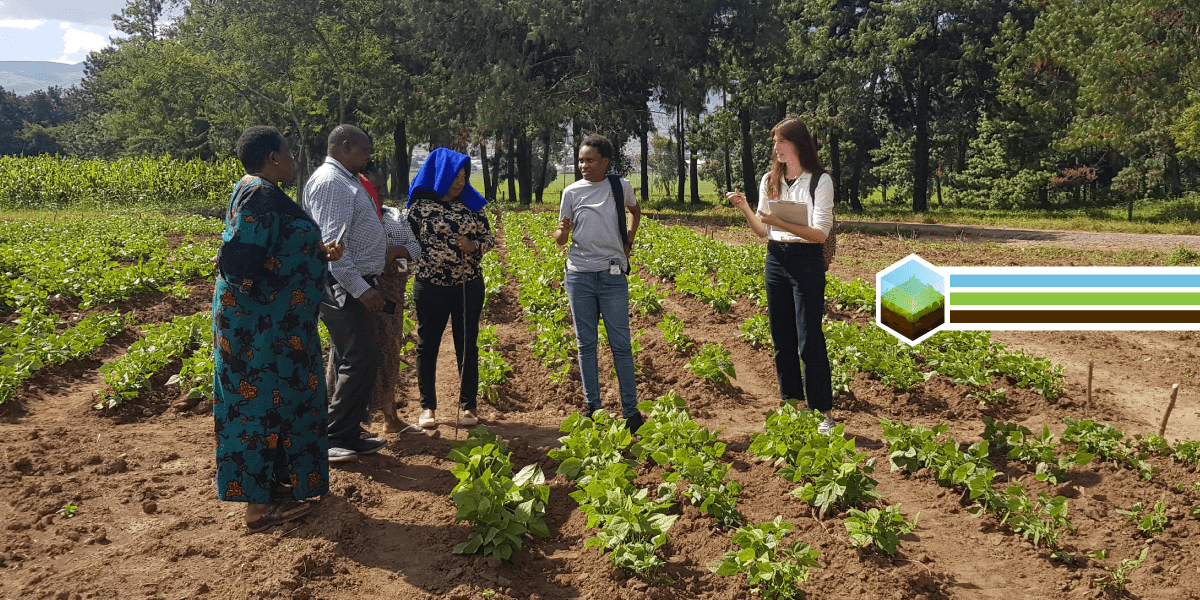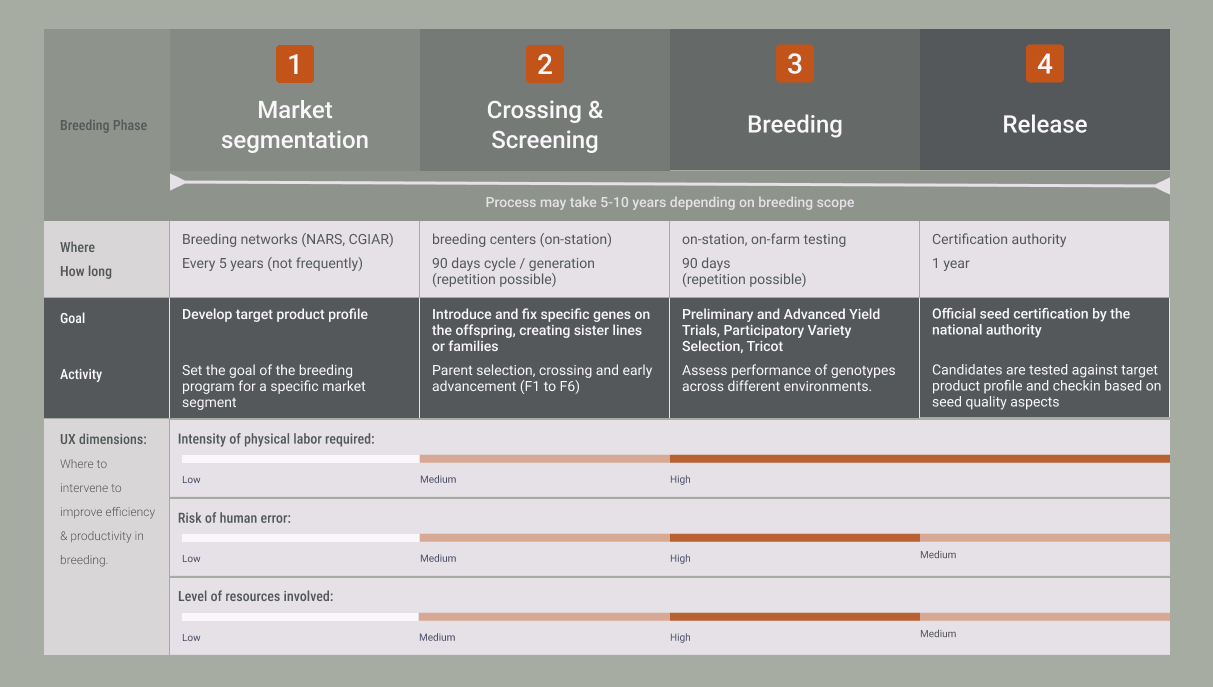Blog In the Breeder’s Shoes

How can we enable digital phenotyping tools in breeding stations across Africa? Researchers working with Tanzanian breeders aim to understand breeders’ main challenges, and explore how digital tools can facilitate their work.
By: Berta Ortiz Crespo and Aline Wiensheimer
Introduction
In Tanzania – as in many parts of Africa – growing beans plays a crucial role in ensuring food security, improving agricultural productivity, and increasing financial stability. The Alliance’s Artemis project plays a key role in enabling bean breeding programs by developing an AI-supported phenotyping technology that will improve the productivity of these programs across Africa. In this transformation process, human-centered design plays a crucial role in understanding the existing breeding practices, and identifying the needs for advancing phenotyping solutions within Artemis. Moreover, this approach identifies suitable entry points for the integration of the phenotyping tool into farmers’ planning practices.
Insights Collection
During the exploration stage we aim to understand who we are designing for, and what the breeding program looks like day-to-day. To achieve this goal, researchers from Artemis conducted one-on-one interviews with four national breeders and eight breeding team members during a visit to Tanzania. The researchers gathered valuable feedback and insights from these interactions, and accompanied phenotyping teams to the field, observing farmers’ day-to-day processes that provided another layer of insights.
Synthesizing Insights - Distinct Breeder Personas and Experience Map
After an intensive insights collection process, the next step was to synthesize research findings. To do so, we created two main design artefacts to aid the design process, informing the characteristics of the product:
Breeding Personas: Putting a human behind the breeding roles
Personas are a communication and empathy tool that provide insights about how groups of users behave, how they think, what they want to accomplish, as well as their motivations. The Artemis team identified three exemplary users of the Artemis tool, who represent primary users of the phenotyping technology.
First, we present Hassan (Figure 1): Hassan leads a team at the National Agricultural Research Institute. His work is often constrained by limited resources and infrastructure, which blocks the collection of necessary phenotyping data from remote trial sites. Hassan believes that digital innovations can enhance efficiency and accuracy in phenotyping data collection and data analysis. However, improving digital literacy among his team members is essential to leverage agronomy software and tools.

The other two profiles we have identified: Mikaeli and Miriam. Mikaeli is a regional research and breeding coordinator, supporting breeding teams in numerous countries. He supplies breeding material to the national teams and frequently carries out the most sensitive stages in the breeding process (such as initial crossing). Although he believes that technological innovations could increase the reach of the programs he leads, he is concerned that new technologies might hinder the program’s progress, because the team would need to learn about the technologies from scratch. He sees data ownership and privacy policies as challenges to the upscaling of these phenotyping tools.
Lastly, as a key contributor to on-station breeding operations we identified Mariam, a technician at the Tanzanian National Research Center. Mariam is a strong supporter of advanced technology, and she believes that these innovations could eliminate phenotyping barriers while enhancing the quality of data, thus reducing her workload. She is very eager to learn about technological advances and is confident in her ability to independently apply new tools with proper training.
Workflow - Mapping the breeding workflow

Another important stage in the process of empathizing with breeding practices was to map the breeding workflow for each user profile (Figure 2). This provided an understanding of how breeding programs work, providing insights into the different stages and decision-making processes. This comprehensive mapping exercise enabled us to unravel the complexities of phenotyping, ensuring that we consider all key aspects. The breeding program typically lasts 10 years, consisting of four primary phases: 1) market segmentation, 2) crossing and screening, 3) breeding and 4) variety release – the outcome of the phenotyping process.
The journey for each user profile allowed Artemis researchers to adopt the breeder's perspective, increasing effective communication and ensuring a shared understanding of the user's journey within the project. This alignment of experiences increases collaboration and establishes a common foundation for human-centered design. This approach ensures the development of solutions tailored to the breeder's preferences and goals, making it more likely that Artemis’s proposed solutions align with the needs and expectations of the intended users.
Conclusions
Through this mapping processes, Artemis researchers identified a clear need for technological interventions to address the challenges faced by breeders in Tanzania. Artemis' mobile phone-based phenotyping technology presents a promising solution to facilitate breeding practices. The integration of this technology can offer the following benefits:
-
Enhanced phenotyping accuracy: Providing breeders with mobile phone-based phenotyping tools can reduce human error in data collection, facilitating the work of technicians such as Mariam. The real-time and standardized data collection process can significantly improve the accuracy of phenotyping information.
-
Streamlined data collection: Breeders such as Hassan work with limited resources, and can benefit from streamlined data collection processes. Mobile phone-based phenotyping tools can replace manual data collection, reducing the burden on breeding teams and improving data efficiency.
-
Accessibility and remote data collection: The Artemis phenotyping technology allows breeders such as Mikaeli to collect data from remote trial sites, even in resource-constrained environments. This feature allows him to access reliable data from research centers and remote locations, overcoming previous challenges.
-
Supporting data analysis: The integration of Artemis technology with other existing breeding tools opens up opportunities for advanced data analysis. Breeders can gain valuable insights from the collected data, enabling more informed decision-making and precise breeding strategies.
Berta Ortiz Crespo
User Experience Design SpecialistOverall, Artemis’s mobile phone-based phenotyping technology addresses breeders’ pressing needs and has huge potential to positively change breeding practices across Africa. By adopting a human-centered design approach we can cater for the diverse needs and challenges faced by breeding teams such as those of Mikaeli, Hassan and Mariam. This approach allows us to provide a tool that enhances their capacity, whilst increasing data accuracy, efficiency and reliability. These advances in phenotyping technology pave the way for the development of data-driven crop varieties, contributing to increased agricultural productivity and improved food security in East Africa, and beyond.




